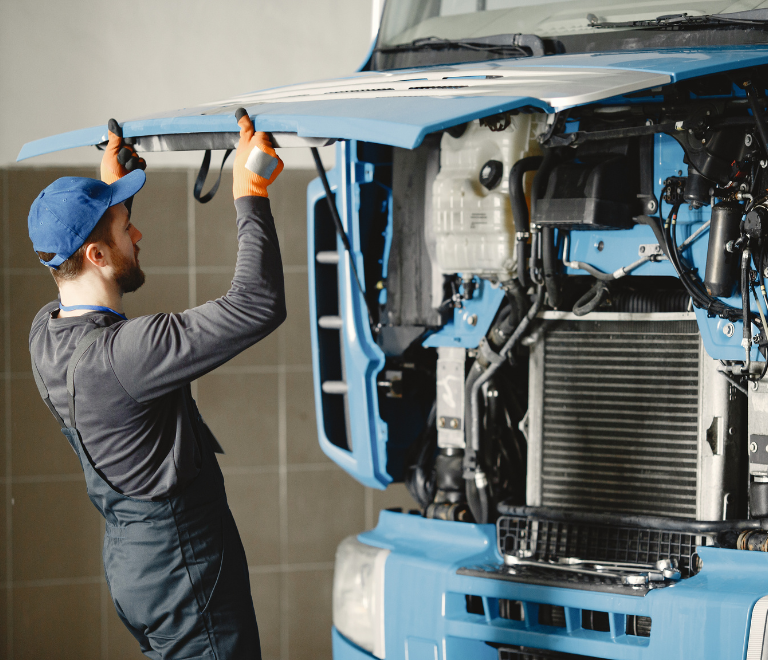In almost every company, truck drivers are important. As unsung heroes, they facilitate timely delivery and transportation of goods, smooth functioning, and effective customer service.
Without a doubt, they are essential to keeping the wheels of commerce rolling, but for them to function at their peak, they need regular maintenance. If not, they can encounter several problems, including expensive repairs and malfunctions that could interfere with your company’s operations.
Whether you’re a truck driver or an owner of a trucking company, this comprehensive truck maintenance checklist can help maintain your vehicles.
It includes everything, including tire maintenance and oil changes. Learn how to take care of your truck now to extend its lifespan rather than waiting for problems to arise, and if this helps, feel free to share them with a fellow trucker.
What Is the Recommended Frequency of Truck Maintenance?
A truck’s type, use, and manufacturer recommendations are just a few of the variables that can affect the maintenance plan. Generally speaking, your truck needs to have the following crucial inspections and repairs performed:
- Rotate tires every 10,000–12,000 kilometers to guarantee uniform tread wear and a longer lifespan.
- Replace essential fluids, check lights, and test brakes every 25,000 kilometers.
- For best results, change the oil and filters every 45,000 kilometers and conduct minor repairs.
- Check the overall state of the truck and the functioning of the engine once a year.
Truck Maintenance Checklist
Preventive and demand maintenance are the two types of truck maintenance. Routine inspections and servicing are part of preventive truck maintenance, which keeps your vehicle in top shape and guarantees smooth operation free from unplanned problems. Typically, the schedule is determined by the truck manufacturer’s recommended miles, engine hours, or time.
Demand truck maintenance, on the other hand, deals with problems as they come up. Because it causes unscheduled downtime and the repair of faulty parts, it is frequently more expensive.
Preventive Maintenance Checklist
As they say, “Prevention is always better than cure.” So, to help you save time and money on regular operations, here are some preventive truck maintenance ideas.
Check For Fluid Leaks
Transmission failure, overheating engines, and other major truck issues can be brought on by fluid leakage. Park your truck levelly and check for fluid leaks under the vehicle and around the engine and transmission. Some leaks may be too small to spot or hidden behind other components. Therefore, take your truck to a certified mechanic for a comprehensive check-up.
Check Engine Oil And Filter
Before anything else, learn the difference between oil filter and engine oil.
The function of the oil filter is to remove harmful debris, metal particles, and dirt from the truck engine. On the other hand, the engine oil protects, lubricates, and lowers friction in the machine which might damage the machine and negatively affect its performance.
To check this, turn off the engine, find the dipstick under the hood, and give it a thorough cleaning, examining any issues. Now, to check the oil level using the indicated markings or crosshatching, fully insert the dipstick, and take it out. Add more oil if the oil level is lower than the indicated minimum mark.
Check the oil:
- if it’s all liquid and appears black or brown, then it’s ok
- if it’s milky-like, it might mean that there’s coolant leakage
- if there are metal particles, it might mean engine damage
Examine Backup Systems
Seatbelts, horns, and door locks are examples of auxiliary devices that improve driver safety and comfort. Therefore, all of these must be working well at all times.
For example, passengers cannot be securely fastened in their seats if their seatbelts are not tight enough. Check the doors and make sure they can be locked firmly. You should also check the horns to see if they are clear and loud. Take your truck to a professional to get these tests fixed if you run across issues.
Examine Vehicle Cab
The main work area for your truck driver is called the cabin or “cab” for short. Maintain its cleanliness at all times, and look for wear, damage, or loose parts on the seats.
Long drives require a seat that is both comfortable and functional. You should also check for technical problems with the dashboard controls, shifter, pedals, and steering wheel.
Last but not least, just as importantly, ensure that you or your truck driver is protected in the event of an accident by the airbags.
Tighten Components
Wear and vibrations over time can cause different truck parts to come loose or fall off. Use the proper tools, such as torque wrenches, socket sets, or wrenches, to tighten any loose or visibly damaged parts on your vehicle.
Pay attention to the manufacturer’s recommendations for the proper torque specifications for each component, as under- or overtightening them can cause major issues.
Check Brakes
Frequent brake repair reduces the risk of accidents and brake-related issues while promoting road safety. Additionally, it guarantees dependable stopping power and lowers the possibility of expensive repairs.
Check brake pads, shoes, discs, drums, fluid levels, and lines for wear, damage, or possible problems. Check that the wheel cylinders or calipers are operating properly and test the parking brake.
Rotate Tires
Finding the tire rotation pattern outlined in your truck’s handbook will help you rotate your tires and ensure even wear long tire life, and peak vehicle performance.
This stage usually entails either crisscrossing the tires in a prescribed pattern or shifting the front tires to the rear and vice versa.
After rotating the tires, retighten the lug nuts in a star or crisscross pattern to the recommended torque and double-check that the tire pressure matches the manufacturer’s requirements. Make sure the lug nuts are loosened before lifting the truck, and use a jack and jack stand for safety.

Demand Maintenance Checklist
Your truck is prone to wear and tear and accidents because it will probably be driven on a variety of highways and terrains. Demand truck maintenance enters the picture here. Use the following checklist to preserve your car in good condition after extended use and stop additional damage.
Repaint The Exterior
When a truck is exposed to several types of weather, the paint may fade, peel, or sustain damage. Allowing it to chip away can cause your car to lose its external barrier protection and look ugly.
Cleaning and sanding your truck’s exterior to get rid of old paint is the first step in repainting it. To guarantee correct adhesion, use a primer first, and then apply thin, even layers of the new paint. Let every coat dry completely before applying another. Apply a clear coat at the end for enhanced protection and a finished look.
Replace batteries
Old car batteries can cause several problems, including trouble starting the engine, poor electrical performance, and the possibility of becoming stranded. To replace old batteries, turn off the engine first and unplug the positive (red) and negative (black) battery wires.
Carefully pull out the old battery by removing any attaching brackets or hold-down devices. Reconnect the connections, tighten them firmly, install the new battery in the same location, and fasten it with brackets.
Replace broken or deteriorated structures
Environmental elements, corrosion, and wear and tear can erode important parts like supports, panels, and frame members. They may weaken your truck’s ability to support loads or expose it to structural damage.
To replace these structures, locate the damaged areas and get the necessary replacement parts from reliable vendors or manufacturers. After obtaining the required parts, raise your truck onto jack stands, take out the damaged structures, and install the new parts in their place.
Replace With New Springs
Truck springs lessen vibrations and provide stability by absorbing and distributing force and impact from the road surface to the vehicle’s chassis. They reduce the strength and performance of your truck’s suspension if they weaken or sag.
To ensure that the suspension system is ready for replacement, give it at least three days’ notice so that oil may be added. After that, raise your truck, take off the base plate, slide off the back wheels, and release the lug nuts.
Take out the old springs and carefully install the new ones, making sure they’re positioned and aligned correctly. Verify that the vehicle’s alignment and suspension settings correspond to the manufacturer’s standards by checking all connections and fasteners one more time.
Check The Engine
The check engine light is one of the many indicators on a truck dashboard; it will come on when a significant component breaks down.
If the engine is on, you might have a worn-out catalytic converter, a filthy or malfunctioning mass airflow sensor, a loose or broken fuel cap, or a damaged oxygen sensor.
To fix these problems, run a diagnostic check for error codes or anomalies in the engine system. Following the manufacturer’s instructions, you should also check the engine compression, oil levels, and spark plugs.
Replace Lights
Truck drivers often drive at night to avoid traffic, thus having headlights and taillights is essential for a safe and effective commute. Driving at night can be difficult and increases the risk of accidents without enough lighting. If your headlights are damaged, remove the wires from the headlight housing by opening the hood.
Remove the old lights carefully. You might need to replace the entire headlamp casing should you accidentally break one of the locking tabs. To change the tail lights, open your trunk or rear hatch, take out the old bulbs and tail light assembly, then replace them with the new ones by closing the locking tabs. Replace the bulb holders and hand-tighten the bolts to secure the system back in place without causing any damage to the housing.
Replace Windows
Truck windows are susceptible to chipping, cracking, and scratches if your car frequently drives on winding, uneven roads. As a result, these kinds of damage can impair the structural integrity of the truck cabin and hinder your driver’s line of sight.
If you have a window that is shattered or severely damaged, remove it, vapor barrier from the frame gently, and vacuum any glass fragments. After giving the window frame a good cleaning, use an appropriate glue or sealer to make a watertight seal. Then, carefully insert the new window into the frame, fasten it firmly, and let the adhesive dry according to the manufacturer’s instructions.
Keep Your Truck’s Performance At Its Best
Maintaining your trucks at their peak performance requires routine maintenance. You can grow your fleet by extending their lives with proper upkeep, which also reduces the need for expensive repairs and downtime.
If you need more tips on how to maintain your trucks, feel free to visit our website for more resources.



